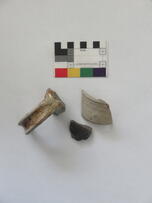Late Neolithic worked flint found with four sherds of Beaker pottery (see JCW04-067)
Six sherds of pottery, consisting of three Nene Valley colour coated wares and three sandy greywares. One of the sherds of Nene Valley ware is decorated with white painted swirls and berries, dating it to the 3rd century AD.
1 with burnt residue on outer
Cutmarks
Oval section fragment
Butchering
SF17: Quatrefoil furniture mount/surround made from sheet copper alloy for a drop-handle, diamond shaped with a central piercing. The petals each have a raised boss and chased radial lines: 27.5mm x 27.9mm, weight 4g. 16th – 17th century in date.
<136>: Badly damaged copper alloy Nuremburg jetton, c. 55% surviving; torn along one side and in poor condition, but most likely a Hanns Krauwinckle type. These are very common on late 16th to early 17th century sites. Probably used as a counting or exchequer token or for gaming (see Egan 2005: 172 for a full discussion of these objects). Diameter 25mm, weigh 3g.
<137>: Large copper alloy jetton or token of similar date and use to <136>; Groat size, c. 30.5mm in diameter and weighing 2g, possibly of French origin and probably 17th century in date. The inscription is illegible and would benefit from further cleaning and conservation.
<158>: Very thin copper alloy pin, poorly preserved, and missing its head. Pins are ubiquitous items and this example is probably Late Medieval to early post-Medieval in date; length c. 42.6mm, weight <0.5g.
Tr. 1: Several fragments from a heavily corroded and concreted spur c. 75mm wide, probably late 16th to 17th century in date, weighing 101g.
Tr. 2: Pair of corroded and concreted metalworking or smithing pliers. These tools were used in blacksmithing for the removal of nails from horseshoes, hot working and general craft activities (weight 229g, length c. 150mm); found with several square cross- sectioned nails and fragment of a horseshoe (weight 68g and tending to the large, Shire horse size of shoe). Although somewhat corroded these are most likely post-Medieval in date, but provide on-site evidence of metalworking and or smithing.
A total of 627 sherds of pottery (12.7kg) were recovered during the recent investigations conducted at Jesus College. The following discussion of this assemblage has been divided into two sections; the first details the material that was recovered from stratified contexts, and the second the unstratified sherds that were recovered from Trenches 1 and 2.
A total of 359 sherds (7265g) were recovered from unstratified deposits encountered in Trenches 1 and 2. This represents 57.3% of the total assemblage by count, and 57.4% by weight. As Table 2 demonstrates, a very similar range of fabrics are represented as were recovered from the stratified deposits discussed above. No vessels of inherent significance were identified.
The range of material recovered, which was dominated by post- Medieval wares, is broadly typical of assemblages derived from the Cambridge region generally (see Edwards & Hall 1997). No vessels of inherent significance were identified, and the quantity of stratified material was relatively low. Nevertheless, the group is of some significance because to date only a small number of comparable assemblages have been recovered from secure collegiate contexts in Cambridge. In association with the assemblage recovered from the College Library excavations (Evans 1995b), it compliments the material that has previously been recovered from late 16th and early 17th deposits associated with Trinity College’s kitchens (Newman in prep.), from 16th century pits at Gonville & Caius College (Alexander 1995) and from an early 17th century pit group at Pembroke College (Hall 2002), and provides an important contrast with the much more extensive domestic assemblages that are known from the town.
F.06: A mixed context. This contained a sherd of late 18th or early 19th-century creamware (<1g), three sherds of 16th to 17th-century German stoneware (15g), seven sherds of 16th to 17th century glazed redware (29g) and a sherd of 13th to 15th-century brown courseware.
F.19: a 16th or 17th century context. <051> contained 13 sherds of plain red coarseware (120g), two sherds of glazed red earthenware (20g), a sherd of Frechen stoneware (10g), a sherd of lead-glazed earthenware (<1g) and two sherds of residual 13th to 15th century grey coarseware (13g). <046> contained three sherds of glazed red earthenware (10g), a sherd of plain red coarseware (3g) and a sherd of residual 13th to 15th century Medieval Ely ware, which has a 14th century floruit (7g).
F.07: this contained a sherd of 16th to 17th century glazed red earthenware (66g).
A total of 359 sherds (7265g) were recovered from unstratified deposits encountered in Trenches 1 and 2. This represents 57.3% of the total assemblage by count, and 57.4% by weight. As Table 2 demonstrates, a very similar range of fabrics are represented as were recovered from the stratified deposits discussed above. No vessels of inherent significance were identified.
A total of 359 sherds (7265g) were recovered from unstratified deposits encountered in Trenches 1 and 2. This represents 57.3% of the total assemblage by count, and 57.4% by weight. As Table 2 demonstrates, a very similar range of fabrics are represented as were recovered from the stratified deposits discussed above. No vessels of inherent significance were identified.










































